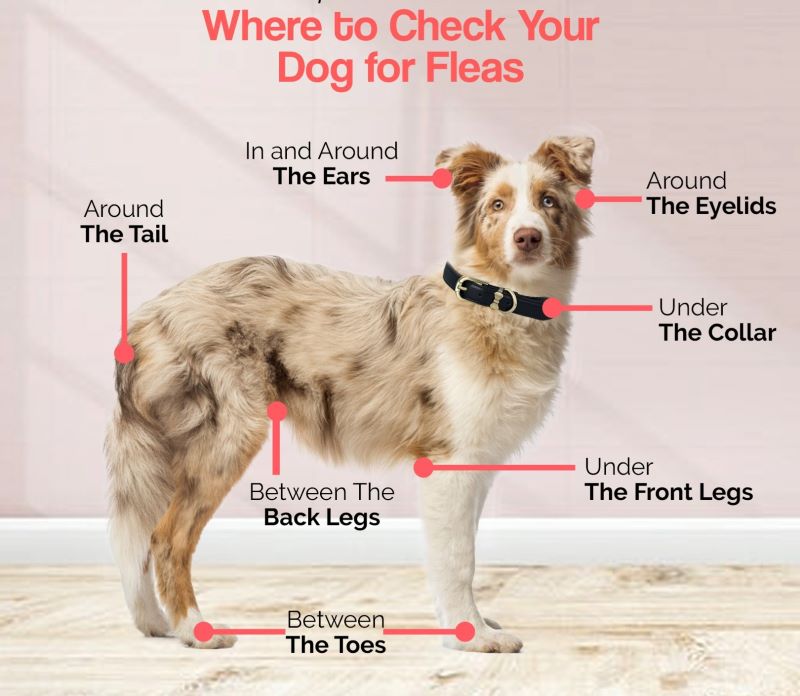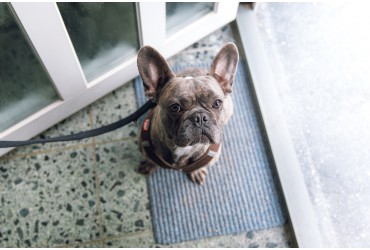Say No To Fleas In Your Dogs!
Warm doggy, soft doggy, little ball of fur… A dog’s soft and warm fur is one of the reasons why we love cuddling them so much – it’s also why fleas find your pet hard to resist! Dogs have quite a high probability of coming into contact with these parasites at some point, but with a bit of know-how you can easily control and treat them.
What are dog fleas?
Dog fleas are the most common parasite your canine friend can come into contact with. They measure about 1-2mm and can live for 7-14 days, dividing their time between living on your dog and laying eggs. Female fleas lay up to 40 eggs every day which are white, oval-shaped and about half a millimetre long. They hatch into tiny larvae that burrow into carpets, upholstery and often your dog’s bedding, which then develop into pupae.
These will lie quietly for many months – you won’t even know they’re there – until they sense warmth and vibration. They then emerge as adult fleas and jump onto a passing ‘host’ – in this case your dog – before starting the cycle all over again! For every single flea it is. High humidity and warm temperatures are when fleas thrive therefore in sunny Singapore, you’ll need to take preventative measures to de-flea all year round.
How do we prevent them?
Prevention is the best cure! Always talk to your vet about dog flea treatments and use a vet-approved product that’s been tested for safety and effectiveness. If you have more than one dog, always treat your pets separately, and try to keep them apart for a period of time so that they don’t risk transferring treatments by contact.There are several options out there, from flea collars to topical liquid applicants and pills. If your dog is already infected with fleas, you can still use preventatives to kill them, however you may need to take more aggressive action, like a prescription preventative. You can also use a flea shampoo or a fast-acting chemical treatment, such as a flea pill that kills the fleas on your dog within hours. Your vet will know what’s best so always consult them first.
Serious diseases your dog can get from fleas and ticks:
- Anemia
Anemia is the state of having less-than-adequate numbers of red blood cells. If a dog has enough ticks, or in the case of small puppies, fleas, they can lose enough blood to become anemic. If the situation persists long enough, tissue damage and even death can occur, due to the chronic low oxygen state.
- Lyme disease
Most of us have heard of Lyme disease, because it affects a lot of people. But dogs can get Lyme disease as well. Lyme is transmitted to dogs when a tick of the Ixodes family tick attaches itself and feeds for more than 24 hours. During this time, the bacteria Borrelia burgdorferi (don’t worry, there’s no quiz at the end) gets transmitted to the dog from the tick, infecting the dog with Lyme disease. It is a very serious, irreversible, and potentially lethal form of kidney disease that causes protein to be rapidly lost from the body in the urine.
- Flea Allergic Dermatitis
FAD (flea allergic dermatitis) isn’t a life threatening disease, but there’s no doubt that it makes many dogs feel miserable. Dogs with FAD can undergo an immune reaction to even a single flea bite, and become intensely itchy.
- Tick paralysis
Few diseases are more frightening to dog owners than those that render their dogs suddenly incapable of moving normally. Tick paralysis starts by causing paralysis in the hind end that slowly progresses towards the head, ultimately paralyzing the respiratory muscles and rendering the dog unable to breathe. One of the hallmark signs of the disease is that in the early stages, the dog cannot rise or walk, but can still wag its tail.
- Babesiosis
Babesiosis is another tick-transmitted disease that causes affected dogs to have very non-specific signs, such as lethargy and mild fever. Treatment isn’t easy or straightforward, and sometimes multiple antibiotics must be used.
Get them out of the house too!
Killing the fleas on your dog is just one part of the problem, remember you’ll have to treat your house as well as your dog which can require lots of patience! It can take as long as three-to-four months to get rid of an infestation, as it takes this long for all of the fleas in your home to go through their life stages.
- Wash all dog beds and soft dog toys in hot, soapy water. Repeat this frequently until the infestation has ended.
- Wash your own bedding, throw rugs, bath mats, and any blanket or cushion where your dog likes to sleep in hot water.
- Vacuum all carpets and floor and throw away the vacuum bag immediately in an outside garbage bin. You will need to vacuum on a regular basis to be sure all of the stages are addressed.
- Choose and apply an environmental flea control spray to disinfect and that will kill all stages of fleas.
- If your dog has ridden in your car lately, you should vacuum the seats.
- Continue to treat your dog and any other pets with a monthly preventative.
How to spot fleas?

Just because they’re not obvious to the human eye, it doesn’t mean they’re not there! Here are some common signs that could indicate your dog has caught the flea bug:
- Excessive scratching, itching, biting, licking
- Loss of hair: Primarily over the lower back, tail and rear leg region
- Fleas Bites
- Scabs
- Abnormal red patches of skin
- Small bumps around body or neck area
- Yeast and bacterial infections
- Skin Infections
- Ear infections
- Flea Dirt

Grooming
Regular grooming won’t prevent fleas on your dog, but it will at least alert you to any symptoms sooner rather than later, so you can seek treatment as soon as possible.Lucky for you and your pet, groomers are often experts at finding fleas and performing “flea funerals.” Tiny and fast moving, it’s entirely possible for your dog to have fleas that you don’t know about. During a thorough grooming, an experienced pet groomer will be able to check out every part of your dogs’ body while they wash, dry and brush your pet. If there are fleas, they will see them.
If you’re worried your dog might be facing a flea problem, why not book a grooming session with us at Pet Master? Our professional and welcoming groomers are always delighted to offer advice and tips to keep those pesky fleas away! Click here to find out more about our grooming services!



